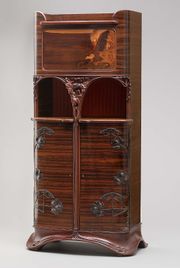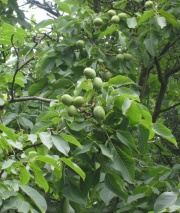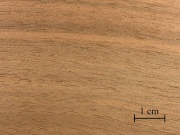Difference between revisions of "English walnut"
| (One intermediate revision by the same user not shown) | |||
| Line 1: | Line 1: | ||
[[File:French cabinet MFA.jpg|thumb|Cabinet dit le Nid d'aigle<br>MFA# 2005.525]] | [[File:French cabinet MFA.jpg|thumb|Cabinet dit le Nid d'aigle<br>MFA# 2005.525]] | ||
| − | [[File:Juglansregiaf5.jpg|thumb|]] | + | [[File:Juglansregiaf5.jpg|thumb|''Juglans regia'']] |
[[File:French_walnut.jpg|thumb|French walnut (''Juglans regia'')]] | [[File:French_walnut.jpg|thumb|French walnut (''Juglans regia'')]] | ||
== Description == | == Description == | ||
| Line 18: | Line 18: | ||
* Wood has low acidity. | * Wood has low acidity. | ||
* Density = 38-48 ppcf | * Density = 38-48 ppcf | ||
| + | |||
| + | ==Working Properties== | ||
| + | * Easy to work provided the grain is straight and regular. Planer tearout can sometimes be a problem when surfacing pieces with irregular or figured grain. | ||
| + | * Glues, stains, and finishes well, (though walnut is rarely stained). | ||
==Resources and Citations== | ==Resources and Citations== | ||
| + | * The Wood Database: [https://www.wood-database.com/english-walnut/ English walnut] | ||
* Schoch, W., Heller, I., Schweingruber, F.H., Kienast, F., 2004:[http://www.woodanatomy.ch/ Wood anatomy of central European Species]: Walnut,[http://www.woodanatomy.ch/species.php?code=JGRE Juglans regia L.] | * Schoch, W., Heller, I., Schweingruber, F.H., Kienast, F., 2004:[http://www.woodanatomy.ch/ Wood anatomy of central European Species]: Walnut,[http://www.woodanatomy.ch/species.php?code=JGRE Juglans regia L.] | ||
Latest revision as of 07:12, 2 August 2022
Description
A deciduous hardwood tree, Juglans regia, known for its timber and its nuts. The English walnut is native to Europe and parts of Asia. The wood from the English walnut tree is a uniform, deep brown color with a medium texture and a close, straight grain. It is strong but easy to work and polishes to a high gloss. Walnut wood is used for furniture, veneers, cabinets, paneling and gum stocks. Burrs, called oyster veneers, are especially prized in the furniture trade. Other portions of the tree also have commercial value. The nut kernels are used for cooking and the pale yellow fast-drying oil expressed from the nuts is used for artists paints. Tannins and dyes are extracted from the walnut hulls and shells that produces a brown color. Ground nut shells have been used as a soft abrasive and a plastic filler.
Synonyms and Related Terms
Juglans regia; noyer (Fr.); nogal (Esp.); nogueira (Port.); noce (It.); French walnut; Queen Ann's cabinet wood; Persian walnut; oyster veneer
Physical and Chemical Properties
- Medium tree growing to 20 m with spheroid crown.
- Bark=light gray with flattened ridges in diamond shaped pattern
- Leaves=pinnate with 5 to 7 ovate leaflets (15 to 20 cm long).
- Fruit=round, edible nut (5 cm diameter) with bright green husk, matures in fall.
- Wood has low acidity.
- Density = 38-48 ppcf
Working Properties
- Easy to work provided the grain is straight and regular. Planer tearout can sometimes be a problem when surfacing pieces with irregular or figured grain.
- Glues, stains, and finishes well, (though walnut is rarely stained).
Resources and Citations
- The Wood Database: English walnut
- Schoch, W., Heller, I., Schweingruber, F.H., Kienast, F., 2004:Wood anatomy of central European Species: Walnut,Juglans regia L.
- Ralph Mayer, A Dictionary of Art Terms and Techniques, Harper and Row Publishers, New York, 1969 (also 1945 printing)
- Hermann Kuhn, Conservation and Restoration of Works of Art and Antiquities, Butterworths, London, 1986
- F. H. Titmuss, Commercial Timbers of the World, The Technical Press Ltd., London, 1965
- Virginia Tech Dendrology website at www.fw.vt.edu/dendro/dendrology/main.htm (accessed Dec. 29, 2005)
- J. Thornton, 'The Use of Dyes and Colored Varnishes in Wood Polychromy', Painted Wood: History and Conservation, The Getty Conservation Insitute, Los Angeles, 1998 Comment: Virginia Tech Dendrology website at www.fw.vt.edu/dendro/dendrology/main.htm (accessed Oct. 8, 2005)
- Wikipedia: http://en.wikipedia.org/wiki/English_walnut (Accessed Oct. 8, 2005)
- George Savage, Art and Antique Restorer's Handbook, Rockliff Publishing Corp, London, 1954
- Pam Hatchfield, Pollutants in the Museum Environment, Archetype Press, London, 2002 Comment: low acidity


